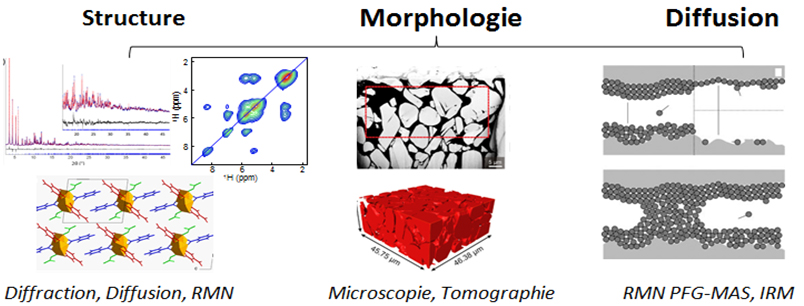Towards a real time and multi-technique characterization
It is essential to understand how porous materials are formed and how they work, regardless of their structure, size, properties or transport phenomena involved (viscosity, electrical conductivity, diffusion). This allows the chemist to be guided in the preparation or shaping of new, more efficient porous solids.
For applications of capture of molecules with environmental impact or controlled release of drugs, we are looking for example to visualize networks of pores large enough (more than 30 nm) and to determine the mechanisms of diffusion and fixation of the molecules in the pores .
This requires the use of advanced techniques, often complementary to one another. These include magnetic resonance (NMR and MRI), transmission electron microscopy or atomic force electron microscopy, X-ray diffraction (XRD), small angle scattering (SAXS) and absorption spectroscopy (XAS).
NMR and MRI can be used to study the local structure of porous networks and the motions of molecules adsorbed in pores over a wide range of temporal and spatial scales. The various synchrotron techniques make it possible to elucidate the structure of materials at different scales in in situ conditions, ie in a controlled environment, or in operation, in operando. The temporal resolution from one microsecond to a few seconds makes it possible to follow the genesis of the materials and the structural or electronic changes produced during the reaction. The morphology and size of the fine pores (from 0.5 nm to several tens of nanometers) can also be determined by SAXS, with a possible follow-up of the intrusion of the guest molecule into the pores. Three-dimensional imaging, such as micro- and nanotomography, or two-dimensional atomic selectivity, such as scanning microscopy, will allow to visualize and quantify, respectively, pore networks of more than 30 nm, and the adsorption of species in the porous network.
If these techniques are already used, alone or coupled together (figure), to characterize porous solids, especially in situ, future developments should allow to go further and to follow the porous solids in operation (in operando) under conditions close to those used.
Facilitating the access of research teams to the available platforms within the network, developing state-of-the-art techniques and making everyone benefit from the expertise of each member is essential to create and optimize the materials of tomorrow.
